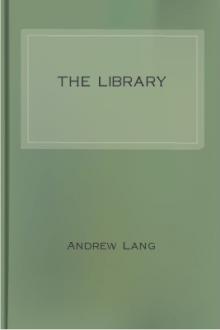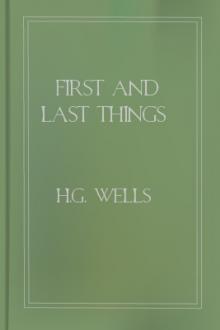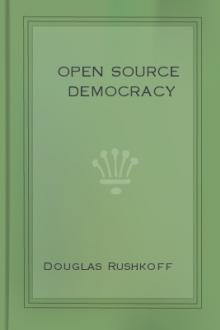The Library by Andrew Lang (i have read the book a hundred times txt) 📕

- Author: Andrew Lang
- Performer: -
Book online «The Library by Andrew Lang (i have read the book a hundred times txt) 📕». Author Andrew Lang
At Versailles, Madame Du Barry heard of the literary genius of Madame de Pompadour. The Pompadour was a person of taste. Her large library of some four thousand works of the lightest sort of light literature was bound by Biziaux. Mr. Toovey possesses the Brantome of this dame galante. Madame herself had published etchings by her own fair hands; and to hear of these things excited the emulation of Madame Du Barry. She might not be CLEVER, but she could have a library like another, if libraries were in fashion.
One day Madame Du Barry astonished the Court by announcing that her collection of books would presently arrive at Versailles. Meantime she took counsel with a bookseller, who bought up examples of all the cheap “remainders,” as they are called in the trade, that he could lay his hands upon. The whole assortment, about one thousand volumes in all, was hastily bound in rose morocco, elegantly gilt, and stamped with the arms of the noble house of Du Barry. The bill which Madame Du Barry owed her enterprising agent is still in existence. The thousand volumes cost about three francs each; the binding (extremely cheap) came to nearly as much. The amusing thing is that the bookseller, in the catalogue which he sent with the improvised library, marked the books which Madame Du Barry possessed BEFORE her large order was so punctually executed. There were two “Memoires de Du Barry,” an old newspaper, two or three plays, and “L’Historie Amoureuse de Pierre le Long.” Louis XV. observed with pride that, though Madame Pompadour had possessed a larger library, that of Madame Du Barry was the better selected. Thanks to her new collection, the lady learned to read with fluency, but she never overcame the difficulties of spelling.
A lady collector who loved books not very well perhaps, but certainly not wisely, was the unhappy Marie Antoinette. The controversy in France about the private character of the Queen has been as acrimonious as the Scotch discussion about Mary Stuart.
Evidence, good and bad, letters as apocryphal as the letters of the famous “casket,” have been produced on both sides. A few years ago, under the empire, M. Louis Lacour found a manuscript catalogue of the books in the Queen’s boudoir. They were all novels of the flimsiest sort,—“L’Amitie Dangereuse,” “Les Suites d’un Moment d’Erreur,” and even the stories of Louvet and of Retif de la Bretonne. These volumes all bore the letters “C. T.” (Chateau de Trianon), and during the Revolution they were scattered among the various public libraries of Paris. The Queen’s more important library was at the Tuileries, but at Versailles she had only three books, as the commissioners of the Convention found, when they made an inventory of the property of la femme Capet. Among the three was the “Gerusalemme Liberata,” printed, with eighty exquisite designs by Cochin, at the expense of “Monsieur,” afterwards Louis XVIII.
Books with the arms of Marie Antoinette are very rare in private collections; in sales they are as much sought after as those of Madame Du Barry.
With these illustrations of the kind of interest that belongs to books of old collectors, we may close this chapter. The reader has before him a list, with examples, of the kinds of books at present most in vogue among amateurs. He must judge for himself whether he will follow the fashion, by aid either of a long purse or of patient research, or whether he will find out new paths for himself. A scholar is rarely a rich man. He cannot compete with plutocrats who buy by deputy. But, if he pursues the works he really needs, he may make a valuable collection. He cannot go far wrong while he brings together the books that he finds most congenial to his own taste and most useful to his own studies. Here, then, in the words of the old “sentiment,” I bid him farewell, and wish “success to his inclinations, provided they are virtuous.” There is a set of collectors, alas! whose inclinations are not virtuous. The most famous of them, a Frenchman, observed that his own collection of bad books was unique. That of an English rival, he admitted, was respectable,—“mais milord se livre a des autres preoccupations!”
He thought a collector’s whole heart should be with his treasures.
En bouquinant se trouve grand soulas.
Soubent m’en vay musant, a petis pas, Au long des quais, pour flairer maint bieux livre.
Des Elzevier la Sphere me rend yure,
Et la Sirene aussi m’esmeut. Grand cas Fais-je d’Estienne, Aide, ou Dolet. Mais Ias!
Le vieux Caxton ne se rencontre pas,
Plus qu’ agneau d’or parmi jetons de cuivre, En bouquinant!
Pour tout plaisir que l’on goute icy-bas La Grace a Dieu. Mieux vaut, sans altercas, Chasser bouquin: Nul mal n’en peult s’ensuivre.
Dr sus au livre: il est le grand appas.
Clair est le ciel. Amis, qui veut me suivre En bouquinant?
A. L.
ILLUSTRATED BOOKS {8}
Modern English book-illustration—to which the present chapter is restricted -has no long or doubtful history, since to find its first beginnings, it is needless to go farther back than the last quarter of the eighteenth century. Not that “illustrated” books of a certain class were by any means unknown before that period. On the contrary, for many years previously, literature had boasted its “sculptures” of be-wigged and be-laurelled “worthies,” its “prospects” and “land-skips,” its phenomenal monsters and its “curious antiques.” But, despite the couplet in the “Dunciad”
respecting books where
” … the pictures for the page atone, And Quarles is saved by beauties not his own;” -
illustrations, in which the designer attempted the actual delineation of scenes or occurrences in the text, were certainly not common when Pope wrote, nor were they for some time afterwards either very numerous or very noteworthy. There are Hogarth’s engravings to “Hudibras” and “Don Quixote;” there are the designs of his crony Frank Hayman to Theobald’s “Shakespeare,” to Milton, to Pope, to Cervantes; there are Pine’s “Horace” and Sturt’s “Prayer-Book” (in both of which text and ornament were alike engraved); there are the historical and topographical drawings of Sandby, Wale, and others; and yet—notwithstanding all these—it is with Bewick’s cuts to Gay’s “Fables” in 1779, and Stothard’s plates to Harrison’s “Novelist’s Magazine” in 1780, that book-illustration by imaginative compositions really begins to flourish in England. Those little masterpieces of the Newcastle artist brought about a revival of wood-engraving which continues to this day; but engraving upon metal, as a means of decorating books, practically came to an end with the “Annuals” of thirty years ago. It will therefore be well to speak first of illustrations upon copper and steel.
Stothard, Blake, and Flaxman are the names that come freshest to memory in this connection. For a period of fifty years Stothard stands pre-eminent in illustrated literature. Measuring time by poets, he may be said to have lent something of his fancy and amenity to most of the writers from Cowper to Rogers. As a draughtsman he is undoubtedly weak: his figures are often limp and invertebrate, and his type of beauty insipid. Still, regarded as groups, the majority of his designs are exquisite, and he possessed one all-pervading and un-English quality—the quality of grace.
This is his dominant note. Nothing can be more seductive than the suave flow of his line, his feeling for costume, his gentle and chastened humour. Many of his women and children are models of purity and innocence. But he works at ease only within the limits of his special powers; he is happier in the pastoral and domestic than the heroic and supernatural, and his style is better fitted to the formal salutations of “Clarissa” and “Sir Charles Grandison,”
than the rough horse-play of “Peregrine Pickle.” Where Rowlandson would have revelled, Stothard would be awkward and constrained; where Blake would give us a new sensation, Stothard would be poor and mechanical. Nevertheless the gifts he possessed were thoroughly recognised in his own day, and brought him, if not riches, at least competence and honour. It is said that more than three thousand of his drawings have been engraved, and they are scattered through a hundred publications. Those to the “Pilgrim’s Progress” and the poems of Rogers are commonly spoken of as his best, though he never excelled some of the old-fashioned plates (with their pretty borders in the style of Gravelot and the Frenchmen) to Richardson’s novels, and such forgotten “classics” as “Joe Thompson”, “Jessamy,” “Betsy Thoughtless,” and one or two others in Harrison’s very miscellaneous collection.
Stothard was fortunate in his engravers. Besides James Heath, his best interpreter, Schiavonetti, Sharp, Finden, the Cookes, Bartolozzi, most of the fashionable translators into copper were busily employed upon his inventions. Among the rest was an artist of powers far greater than his own, although scarcely so happy in turning them to profitable account. The genius of William Blake was not a marketable commodity in the same way as Stothard’s talent.
The one caught the trick of the time with his facile elegance; the other scorned to make any concessions, either in conception or execution, to the mere popularity of prettiness.
“Give pensions to the learned pig,
Or the hare playing on a tabor;
Anglus can never see perfection
But in the journeyman’s labour,” -
he wrote in one of those rough-hewn and bitter epigrams of his. Yet the work that was then so lukewarmly received—if, indeed, it can be said to have been received at all—is at present far more sought after than Stothard’s, and the prices now given for the “Songs of Innocence and Experience,” the “Inventions to the Book of Job,” and even “The Grave,” would have brought affluence to the struggling artist, who (as Cromek taunted him) was frequently “reduced so low as to be obliged to live on half a guinea a week.” Not that this was entirely the fault of his contemporaries. Blake was a visionary, and an untuneable man; and, like others who work for the select public of all ages, he could not always escape the consequence that the select public of his own, however willing, were scarcely numerous enough to support him. His most individual works are the “Songs of Innocence,” 1789, and the “Songs of Experience,”
1794. These, afterwards united in one volume, were unique in their method of production; indeed, they do not perhaps strictly come within the category of what is generally understood to be copperplate engraving. The drawings were outlined and the songs written upon the metal with some liquid that resisted the action of acid, and the remainder of the surface of the plate was eaten away with aqua-fortis, leaving the design in bold relief, like a rude stereotype. This was then printed off in the predominant tone—
blue, brown, or yellow, as the case might be—and delicately tinted by the artist in a prismatic and ethereal fashion peculiarly his own. Stitched and bound in boards by Mrs. Blake, a certain number of these leaflets—twenty-seven in the case of the first issue—made up a tiny octavo of a wholly exceptional kind. Words indeed fail to exactly describe the flower-like beauty—the fascination of these “fairy missals,” in which, it has been finely said, “the thrilling music of the verse, and the gentle bedazzlement of the lines and colours so intermingle, that the mind hangs in a pleasant uncertainty as to whether it is a picture that is singing, or a song which has newly budded and blossomed into colour and form.” The accompanying woodcut, after one of the illustrations to the “Songs of Innocence,” gives some indication of the general composition, but it can convey no hint of the gorgeous purple, and crimson, and orange of the original.
Of the “Illustrations to





Comments (0)